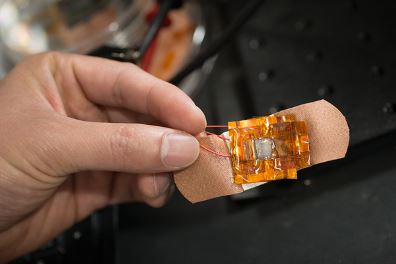Paper thin transistor measures heart health
28 May 2013
A postage-stamp-sized heart monitor developed at Stanford University is thin enough to be worn under a plaster on the wrist and is sensitive enough to help diagnose cardiovascular problems.
Called a flexible pressure-sensitive organic thin film transistor, the sensor can be used for non-invasive, high fidelity, continuous radial artery pulse wave monitoring. It has the potential to continuously track heart health and provide doctors a safer method of measuring a key vital sign for newborn and other high-risk surgery patients.
The sensor has a thin middle layer of rubber covered with tiny pyramids. Each pyramid is only a few microns across — smaller than a human red blood cell.

The pressure-sensitive organic thin film
transistor
that can monitor heart health.
Source:
Linda Cicero / Stanford News Service.
When pressure is put on the device, the pyramids deform slightly, changing the size of the gap between the two halves of the device. This change in separation causes a measurable change in the electromagnetic field and the current flow in the device.
The more pressure placed on the monitor, the more the pyramids deform and the larger the change in the electromagnetic field. Using many of these sensors on a prosthetic limb could act like an electronic skin, creating an artificial sense of touch.
When the sensor is placed on someone's wrist using an adhesive bandage, it can measure the pulse wave as it passes through the body.
"The pulse is related to the condition of the artery and the condition of the heart," said Zhenan Bao, professor of chemical engineering at Stanford, who has developed the sensor. "The better the sensor, the better doctors can catch problems before they develop."
A heart beat is made up of two distinct peaks, the first, larger peak is from the heart pumping out blood. Shortly after a heartbeat, the lower body sends a reflecting wave back to your artery system, creating a smaller second peak.
"You can use the ratio of the two peaks to determine the stiffness of the artery, for example," said Gregor Schwartz, a postdoctoral fellow and a physicist for the project. "If there is a change in the heart's condition, the wave pattern will change."
"In theory, this kind of sensor can be used to measure blood pressure," said Schwartz. "Once you have it calibrated, you can use the signal of your pulse to calculate your blood pressure."
The researchers believe the sensor could replace devices inserted directly into an artery, called intravascular catheters. These catheters create a high risk of infection, making them impractical for newborns and high-risk patients. Thus, an external monitor like this sensor could provide doctors a safer way to gather information about the heart.
Bao's team is working with other Stanford researchers to make the device completely wireless. Using wireless communication, doctors could receive a patient's minute-by-minute heart status via cell phone, all thanks to a device as thick as a human hair.
"For some patients with a potential heart disease, wearing a bandage would allow them to constantly measure their heart's condition," Bao said. "This could be done without interfering with their daily life at all, since it really just requires wearing a small bandage."
Reference
Schwartz G, et al. Flexible polymer transistors with
high pressure sensitivity for application in electronic skin and
health monitoring. Nature Communications, 4, Article number: 1859.
doi:10.1038/ncomms2832
www.nature.com/ncomms/journal/v4/n5/full/ncomms2832.html